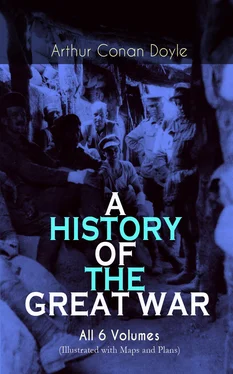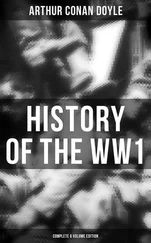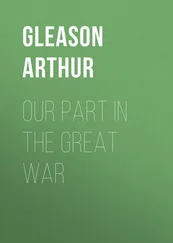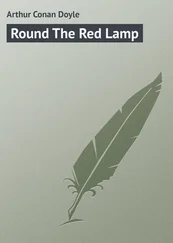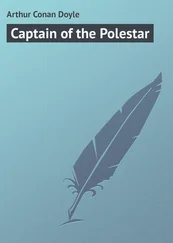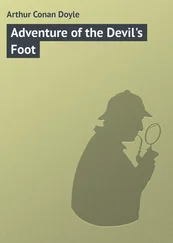The advance of the British upon September 6 was made in unison with that of the Fifth French Army (D’Esperey’s) upon the right, and was much facilitated by the fact that Von Kluck had to detach the strong force already mentioned to deal with Maunoury upon the left. The British advanced with the Fourth Division upon the left, the Second Corps in the centre and the First Corps upon the right. The high banks of the Grand Morin were occupied without serious fighting, and the whole line pushed forward for a considerable distance, halting on the Coulommiers-Maisoncelles front. The brunt of the fighting during the day was borne by the French on either wing, the Third and Fourth German Corps being thrown back by D’Esperey’s men, among whom the Senegal regiments particularly distinguished themselves. The fighting in this section of the field continued far into the night.

British Advance during the Battle of the Marne
On September 7 the British and the Fifth French were still moving northwards, while the Sixth French were continuing their bitter struggle upon the Ourcq. The British infantry losses were not heavy, though a hidden battery cost the South Lancashires of the 7th Brigade forty-one casualties. Most of the fighting depended upon the constant touch between the British cavalry and the German. It was again the French armies upon each flank who did the hard work during this eventful day, the first of the German retreat. The Sixth Army were all day at close grips with Von Kluck, while the Fifth drove the enemy back to the line of the Petit Morin River, carrying Vieux-Maisons at the point of the bayonet. Foch’s army, still farther to the east, was holding its own in a desperate defensive battle.
Of the cavalry skirmishes upon this day one deserves some special record. The 2nd Cavalry Brigade (De Lisle) was acting at the time as flank guard with, the 9th Lancers in front. Coming into contact with some German dragoons near the village of Moncel, there followed a face-to-face charge between two squadrons, each riding through the Marne. other. The American, Coleman, who saw the encounter, reckons the odds in numbers to have been two to one against the Lancers. The British Colonel Campbell was wounded, and the adjutant, Captain Reynolds, transfixed through the shoulder by a lance. While drawing the weapon out Captain Allfrey was killed. The other casualties were slight, and those of the German dragoons were considerably greater. This example of shock tactics was almost instantly followed by an exhibition of those mounted rifleman tactics which have been cultivated of late years. A squadron of the 18th Hussars, having dismounted, was immediately charged by a German squadron in close order. About 70 Germans charged, and 32 were picked up in front of the dismounted Hussars, while the few who passed through the firing line were destroyed by the horse-holders. It may fairly be argued that had the two squadrons met with shock tactics, no such crushing effect could possibly have been attained. It is interesting that in one morning two incidents should have occurred which bore so directly upon the perennial dispute between the partisans of the arme blanche and those of the rifle.
On the 8th the orders were to advance towards Château-Thierry and to endeavour to reach the Marne. The Germans were retreating fast, but rather on account of their generally faulty strategical position than from tactical compulsion, and they covered themselves with continual rearguard actions, especially along the line of the Petit Morin. It is one of the noticeable results, however, of the use of aircraft that the bluff of a rearguard has disappeared and that it is no longer possible to make such a retreat as Masséna from Torres Vedras, where the pursuer never knew if he were striking at a substance or a shadow. Gough’s Second Cavalry Division, which consisted of the 3rd and 5th Brigades, swept along, and the infantry followed hard at the heels of the horses, Doran’s 8th Brigade suffering the loss of about 100 men when held up at the crossing of the Petit Morin River near Orly, which they traversed eventually under an effective covering fire from J Battery, R.H.A.
The First Army Corps upon this day forced the Petit Morin at two places, both near La Trétoire, north of Rebaix. The First Division secured the passage at Sablonnières, where the Black Watch seized the heights, causing the German rearguard some losses and taking 60 prisoners. The Second Division met with considerable resistance, but the 2nd Worcesters got over at Le Gravier and the 2nd Grenadier Guards at La Forge. The enemy was then driven from the river bank into the woods, where they were practically surrounded and had eventually to surrender. Eight machine-guns and 350 prisoners, many of them from the Guards’ Jaeger Battalion, were captured. Six of these machine-guns fell to the Irish Guards.
The Second Army Corps passed the Petit Morin near St. Cyr and St. Ouen, the 13th Brigade attacking the former and the 14th the latter, both being villages on the farther side of the river. Such fighting as there was in this quarter came largely to the 1st East Surrey and 1st Cornwalls, of the 14th Brigade, but the resistance was not great, and was broken by the artillery fire. To the soldiers engaged the whole action was more like a route march with occasional deployments than a battle.
On the 9th the Army was up to the Marne and was faced with the problem of crossing it. The operations extending over many miles were unimportant in detail, though of some consequence in the mass. The real hard fighting was falling upon the Sixth French Army north of Ligny, which was still in desperate conflict with the German right, and upon Foch’s army, which was fighting magnificently at Fère-Champenoise. The advance of the British, and their own exertions, caused the Germans to retire and cleared the passage over the Ourcq for our Allies. The chief losses during the day upon the British side fell upon the Guards’ Brigade, the 1st Lincolns, and the 1st Cornwalls, most of which were inflicted by invisible quick-firing batteries shrouded by the woods which flank the river. The latter regiment lost Colonel Turner, Major Cornish-Bowden, and a number of other killed or wounded in a brilliant piece of woodland fighting, where they drove in a strong German rearguard. The 1st East Surrey, who were very forward in the movement, were also hard hit, having 6 officers and about 120 men out of action.
The British infantry was able on this day to show that woods may serve for other purposes besides hiding batteries. The 1st Lincolns, being held up by a rapid and accurate fire from invisible guns, dispatched two companies, C and D, to make in single file a detour under the shelter of the trees. Coming behind the battery, which appears to have had no immediate support, they poured in a rapid fire at two hundred and fifty yards, which laid every man of the German gunners upon the ground. The whole battery was captured. The casualties of the Lincolns in this dashing exploit, which included Captains Hoskyns and Ellison, with Lieutenant Thruston, were unavoidably caused by British shrapnel, our gunners knowing nothing of the movement.
On this date (September 9) both the First and the Second Army Corps were across the Marne, and advanced some miles to the north of it, killing, wounding, or capturing many hundreds of the enemy. The Sixth French Army was, as stated, fighting hard upon the Ourcq, but the Fifth had won a brilliant success near Montmirail and driven the enemy completely over the river.
Pulteney’s Third Corps, still a division short, had been held up by the destruction of the bridges at La Ferté, but on September 10 they were across and the whole Army sweeping northwards. The cavalry overrode all resistance and rounded up a number of prisoners, over 2000 in all. It was a strange reversal of fortune, for here within a fortnight were the same two armies playing the converse parts, the British eagerly pushing on with a flushed consciousness of victory, while the Germans, tired and dispirited, scattered in groups among the woods or were gathered up from the roadsides. It was a day of mist and rain, with muddy, sodden roads, but all weather is fine weather to the army that is gaining ground. An impression of complete German demoralisation became more widespread as transport, shells, and even guns were found littering the high-roads, and yet there was really even less cause for it than when the same delusion was held by the Germans. The enemy were actually making a hurried but orderly retreat, and these signs of disaster were only the evidence of a broken rearguard resistance. German armies do not readily dissolve. There is no more cohesive force in the world. But they were undoubtedly hard pressed.
Читать дальше
